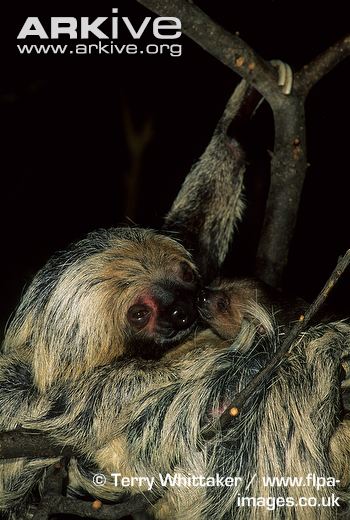
Reproduction
Like all other placental mammals, the offspring of the two-toed sloth remains in the womb of the mother for a period of time and then the female gives birth to the (mostly) developed young. Like other mammalian creatures, two-toed sloths reproduce sexually in which a female egg is fertilized by a male sperm cell. Sloths mate between the months of September and November, generally known as the dry period of the climate. When females are in heat they will often scream to attract nearby males. The whole process of mating takes a very short amount of time-as short as 5 seconds. Mating, like other sloth functions, occurs while hanging from tree branches.
 Female
C. didactylus can begin reproducing around three years of age
with males maturing around four to five years and the female usually has one
offspring a year (Klein, n.d.). A characteristic of all mammals, the
sloth produces milk for the offspring until it is matured enough to
begin an adult diet of leaves and insects. Taube (as cited in Feldhamer,
2007) found that gestation period for a two-toed sloth is around 10
months (but can range from around 7-11) and when the baby is born, it
weighs around 12 ounces (Felton-Church, 2000). As the sloth spends
almost its whole life up in a tree, even birth occurs while hanging from
a branch. Often, this can be a tragic process as in some cases the newly
born sloth falls to its death during birth. When this happens, the
mother will generally stay up in the tree and abandon the young, as its
cries will attract predators (Klein, n.d.).
Female
C. didactylus can begin reproducing around three years of age
with males maturing around four to five years and the female usually has one
offspring a year (Klein, n.d.). A characteristic of all mammals, the
sloth produces milk for the offspring until it is matured enough to
begin an adult diet of leaves and insects. Taube (as cited in Feldhamer,
2007) found that gestation period for a two-toed sloth is around 10
months (but can range from around 7-11) and when the baby is born, it
weighs around 12 ounces (Felton-Church, 2000). As the sloth spends
almost its whole life up in a tree, even birth occurs while hanging from
a branch. Often, this can be a tragic process as in some cases the newly
born sloth falls to its death during birth. When this happens, the
mother will generally stay up in the tree and abandon the young, as its
cries will attract predators (Klein, n.d.).
The young are able to grip the belly of the mother
immediately after birth and don’t gain independence till a minimum of 5
months, 2.5 months after weaning has occurred (Adam, 1999). Mothers and
their offspring often remain in nearby areas and associate with one another for
up to two
years after birth (Taube, 1998). Two-toed sloths are generally
long-lived, even more so in captivity where they can reach up to 31
years of age (Feldhamer, 2007). In the wild, sloths do not reach that
high of an age, but if an individual survives the high infant mortality
rate and lives to maturity, the survival outlook is generally good.